
ARC-Small Grain,
Bethlehem
Most brewing barley is produced under dryland conditions in the Western Cape, while the rest is grown under irrigation near Koedoeskop in Limpopo and the Vaalharts, Modderrivier, Lückhoff and Douglas areas.
Barley, as one of the small grains, shares some of the pest insects that attack wheat and other small grains. Insects that attack wheat are false wireworms, leafhoppers, aphids, bagrada bugs, leaf miners, bollworms and false armyworms (Figure 1). In the Western Cape, grain slugs, red-legged earth mites and cutworms can be added.
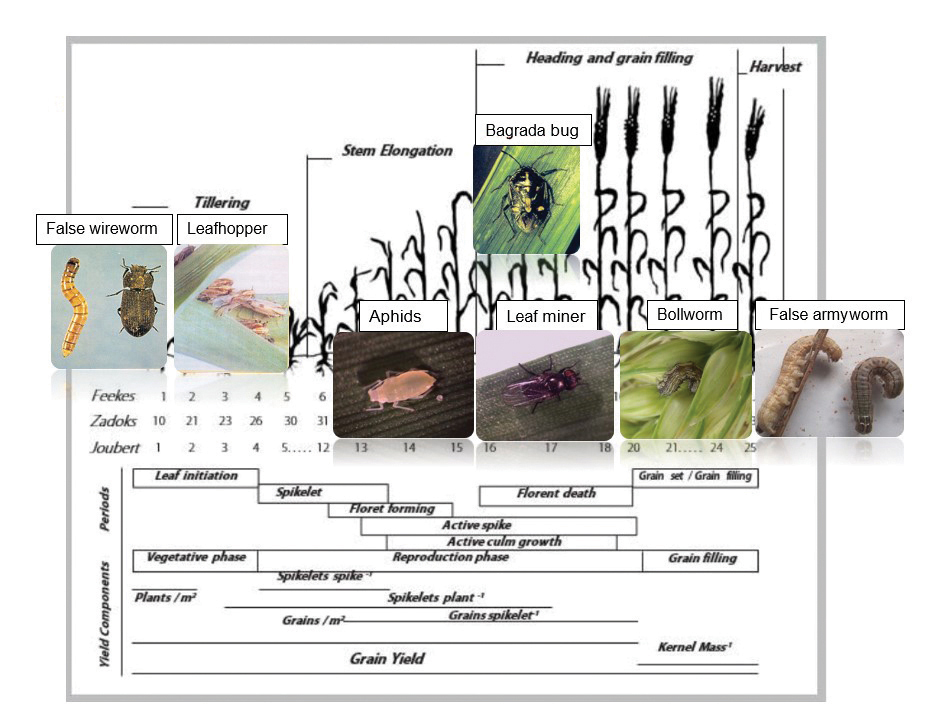
Accumulated knowledge from irrigation areas in the past two decades shows that the most important pests on barley are aphids, bollworms, leaf miners and false armyworms. The rest of the insects are sporadic and not so important. In the Western Cape, except for aphids, leaf miners and false armyworm, red-legged earth mites and cutworms might cause sporadic problems. This article will concentrate on the four most important pests.
Aphids
Aphids are annually present on barley in both the Western Cape and irrigation areas. The three most important species are the oat aphid, the rose grain aphid and the English grain aphid (Photo 1 to Photo 3). Under irrigation, they invade barley fields from flag leaf stage onwards when plants are already in the reproductive stage and all the yield components are fixed. Therefore, these aphids cannot reduce the number of tillers and heads per plant, but in high numbers they are able to reduce the size of the kernels and therefore the grain quality.

These aphids are also able to transmit barley yellow dwarf virus (BYDV). The seriousness of the virus infection depends on the plant growth stage when the virus is transmitted. Aphids transmit the virus into the phloem of the plant where the virus survives and increases in the plant. When transmitted to the plant in the vegetative phase, infection will affect the plant development severely, causing stunted plants, yellowing from the leaf tips and more than 30% yield loss. However, since the aphids in the irrigation areas invade the fields from flag leaf onwards, the effect is again only to reduce the kernel size with a maximum of 2% yield loss.
For feeding damage prevention, aphids should be controlled only at flag leaf stage if 25% of the tillers are infested with more than ten aphids per tiller. Be very cautious to spray specifically in the Western Cape, since many natural enemies are present that will help to control the aphids and could save on input costs.
Leaf miners
Leaf miners are prominent in some irrigation areas and may be present on an annual basis. In the Western Cape they are found regularly just after plant emergence, especially when dry conditions occur. The drought delays plant growth and allows leaf miner eggs to develop inside the leaf. However, vigorous plant growth after rain combats the problem without any effect on yield. Under irrigation, visual damage to plants – especially to the three upper leaves – seems to be serious (Photo 4), but significant decreases in yield have not been recorded during field trials.
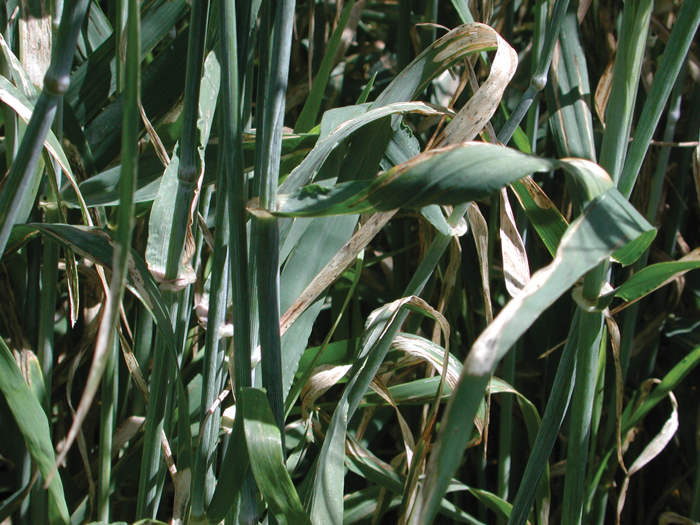
Leaf cutting trials were used to determine the percentage yield loss when the flag leaf and the second leaf were cut off at flowering. According to these trials, the yield loss in barley was 12%. This means that the first two of every tiller’s leaves must be destroyed before this yield loss can be realised – a situation that has never been recorded. A table was constructed from which producers can calculate the potential damage experienced in the field (Table 1). For example, if 50% of the leaf area on the first two leaves was damaged on 50% of all tillers in a field, the yield loss would be 3%. This equals a 240 kg/ha yield loss at a potential of 8 t/ha. At a crop price of R5000/ton, this would mean a loss of R1 200/ha. This should then be compared with the spraying cost per hectare.
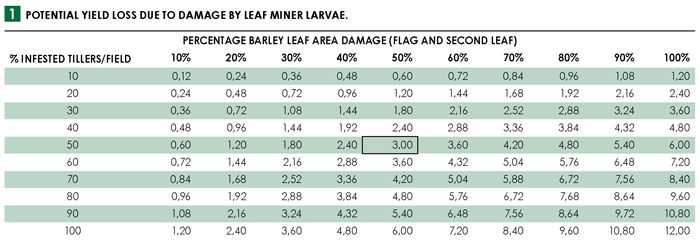 After deciding to spray, producers should take into account that the larvae pupate in the soil. Spraying should therefore be conducted when the larvae are still inside the leaves, before they drop to the soil, otherwise the application will not be effective and will simply be a waste of money.
After deciding to spray, producers should take into account that the larvae pupate in the soil. Spraying should therefore be conducted when the larvae are still inside the leaves, before they drop to the soil, otherwise the application will not be effective and will simply be a waste of money.
Bollworm
In some seasons bollworm can be a serious problem. Larvae smaller than 10 mm are the most damaging, as they burrow through the seeds (Photo 5). This size is not easily observed and producers should therefore intensely scout for them during grain filling. When four to six larvae are found per square meter, producers should spray to prevent economic yield loss. Monitoring moth flight activity with pheromones by using bucket-funnel traps, may help to warn of their presence beforehand.
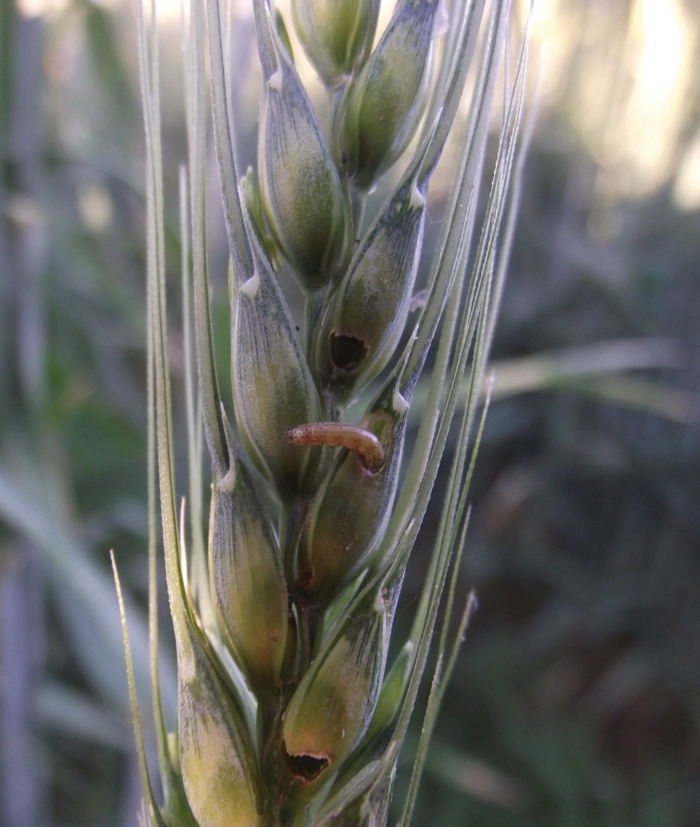
False armyworm
False armyworm activity occurs throughout the year (Graph 1), but varies between the different production areas. The female moths are attracted to lay their eggs by the smell of fermenting, rotten grass, a condition present in the last two or three weeks before harvesting. Barley plants at this stage are soft and vulnerable and the larvae easily cut off the heads and feed on the grain itself. First signs of their presence are typical feeding symptoms on the leaves; they feed from the edges of the leaves inward (Photo 7). Larvae (Photo 6) mostly feed during the night, while during the day they keep to the soil surface underneath plant material. The last three weeks before harvesting are the most critical time.

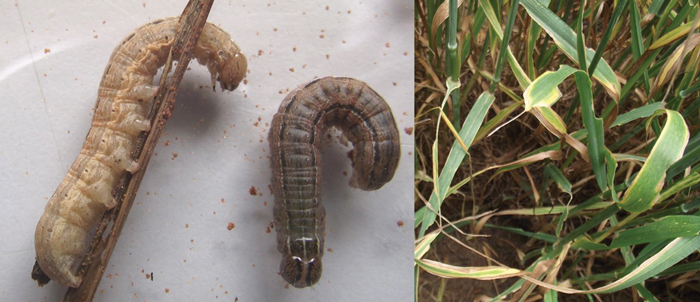
In the Western Cape, high moth activity is present between week 11 and week 28 (mid-March to mid-July). This includes sowing time in this area (Graph 1) and larvae act the same way as cutworm by cutting or damaging the seedlings just after emergence. New moths appear again between week 39 and week 46 (October to mid-November), coinciding with harvest time. This could give rise to many larvae just before harvest time to pose a potential threat. This threat does not usually realise, probably because the grain is swathed during this critical period. Therefore, in the Western Cape this insect could be more of a threat during plant emergence than at the end of the growing season.
The highest moth flight activity in the irrigation areas occurs between week 10 and week 47. In this period strong peaks occur during May and June and then again during September and October. This also coincides with the sowing and reaping of the grain. In these areas the larval activity is very low during the winter, but increases from October onwards.
Since the female moths have the strange phenomenon of laying eggs in the area of fermenting or rotting grass, irrigated fields just before harvest could be an easy target when plants are drying down. This could be so even more during drought conditions, because the moths have no other place to lay their eggs but in the irrigated fields. In 2010, when an outbreak occurred in the Douglas and Vaalharts irrigation areas, this was the case. It is therefore necessary to monitor the moth flight patterns and pay attention to the weather patterns and especially long dry periods before harvest.
For further information, contact ARC-Small Grain at 058 307 4000.
Research was made possible by financial input from the Agricultural Research Council (ARC), the Winter Cereal Trust and AB InBev.





























